There’s something so cozy and satisfying about a dinner that comes together quickly yet tastes like you spent hours in the kitchen. That’s exactly what you get with this Creamy Dijon Mustard Chicken Skillet Recipe—a rich, flavorful sauce that clings perfectly to tender chicken, making every bite a little celebration.
Jump to:
- Why You'll Love This Recipe
- Ingredients & Why They Work
- Make It Your Way
- Step-by-Step: How I Make Creamy Dijon Mustard Chicken Skillet Recipe
- Top Tip
- How to Serve Creamy Dijon Mustard Chicken Skillet Recipe
- Make Ahead and Storage
- Frequently Asked Questions:
- Final Thoughts
- Creamy Dijon Mustard Chicken Skillet Recipe
Why You'll Love This Recipe
From the first time I made this Creamy Dijon Mustard Chicken Skillet Recipe, it became an instant favorite. The balance of tangy mustard with just the right creaminess is pure comfort food that feels fancy but is actually really simple to whip up on any weeknight.
- Quick and easy: You’ll have dinner on the table in about 25 minutes, perfect for busy evenings.
- Deliciously creamy sauce: The Dijon mustard adds a bright kick without overpowering the rich cream base.
- Tender juicy chicken: Flattening the breasts helps them cook evenly and stay moist.
- Versatile and customizable: You can swap herbs, play with sweetness, or add veggies right in the skillet.
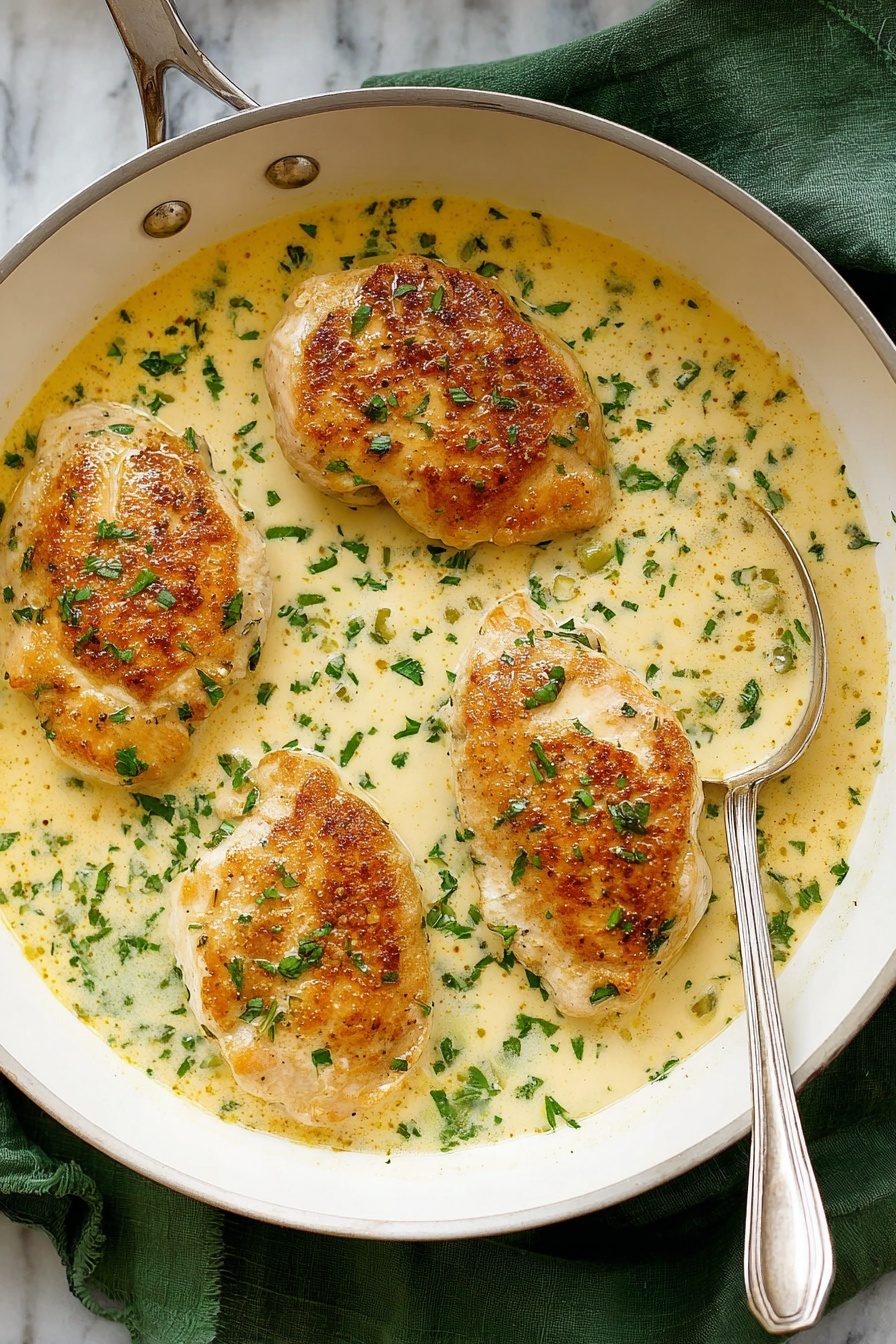
Ingredients & Why They Work
This recipe shines because of how the ingredients complement each other—bright, creamy, and savory. When shopping, look for good-quality Dijon mustard and fresh chicken breasts for the best texture and flavor.
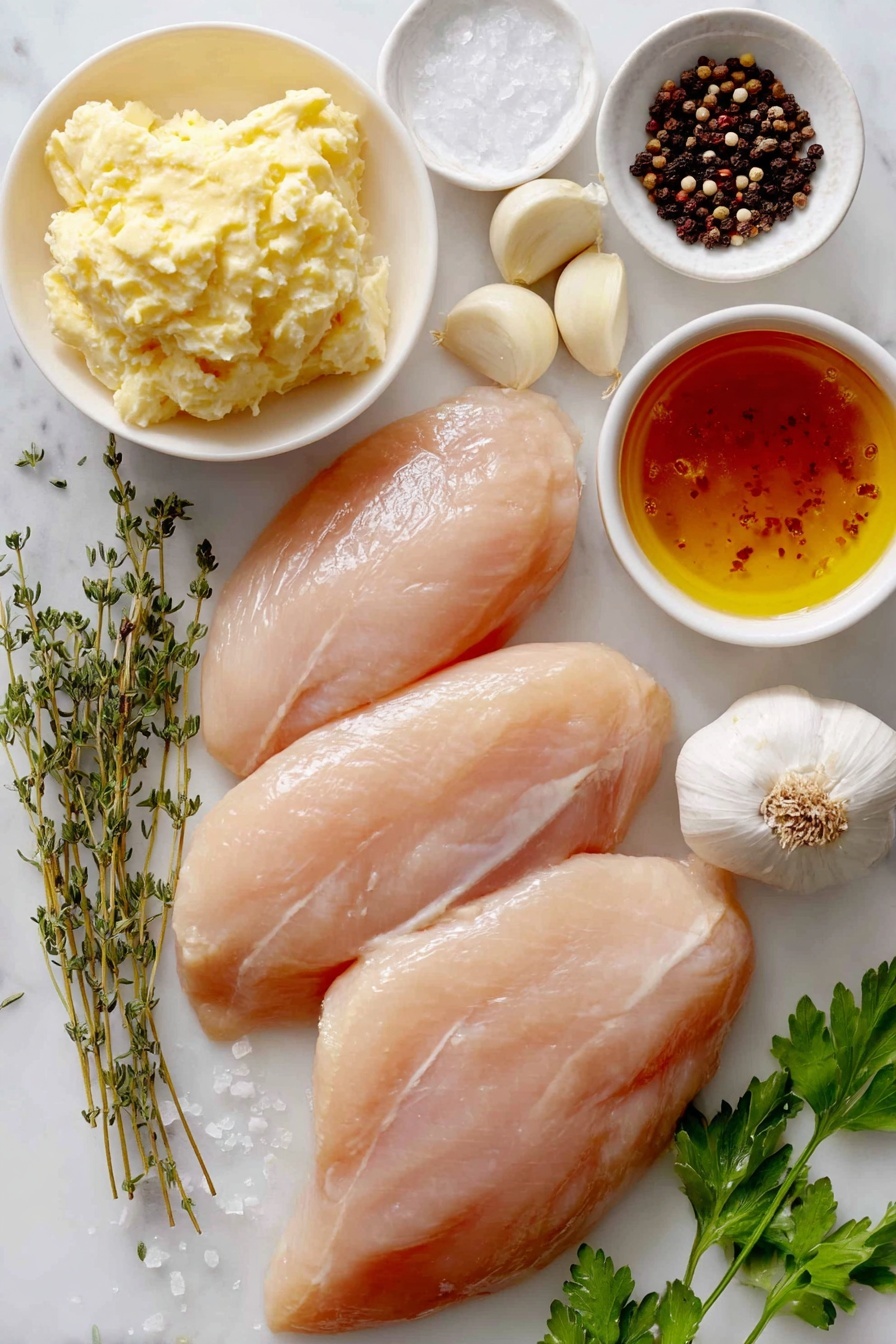
- Boneless skinless chicken breasts: Flattening them ensures even cooking, so you avoid dry edges with a juicy middle.
- Olive oil: Adds a subtle fruitiness and helps get a nice sear on the chicken.
- Minced garlic: Just a touch gives a fragrant base—don’t let it burn or the sauce will taste bitter.
- Low-sodium chicken broth: Keeps the sauce flavorful without overwhelming saltiness, and helps build that rich base.
- Heavy cream: The star of the sauce, giving it that luscious, silky texture we all crave.
- Dijon mustard: Not too harsh but perfectly tangy; Grey Poupon is my favorite for its balance.
- Fresh thyme: Bright herbal notes that bring freshness and depth.
- Dried sage: Adds earthiness and a warm touch—it plays so well with the cream and mustard.
- Honey: A little sweetness rounds out the tangy mustard and balances the whole dish.
- Fresh parsley (optional): A splash of green freshness to finish and brighten the plate.
Make It Your Way
I love to tweak this Creamy Dijon Mustard Chicken Skillet Recipe depending on what’s in my fridge or what flavors I’m craving. Feel free to get creative—there’s plenty of room to adjust the herbs or add some veggies right into the skillet.
- Variation: One time, I swapped out dried sage for rosemary and added mushrooms to the sauce—super delicious and gave the dish an earthy twist.
- Make it lighter: You can replace the heavy cream with half-and-half or a mix of milk and Greek yogurt, though the sauce won’t be as rich.
- Add heat: Stir in a pinch of cayenne or chili flakes if you want a little kick to balance the cream.
- Swap the protein: This sauce pairs beautifully with pork chops or even firm tofu for a vegetarian twist.
Step-by-Step: How I Make Creamy Dijon Mustard Chicken Skillet Recipe
Step 1: Flatten the Chicken for Even Cooking
I like to use a meat mallet or even the bottom of a heavy pan to gently pound the chicken breasts until they’re about ½ inch thick. This step is a game-changer—it helps the chicken cook quickly and evenly, so no dry edges with an undercooked center. Pat the chicken dry with paper towels before seasoning—that helps the sear develop beautifully.
Step 2: Sear the Chicken to Golden Perfection
Heat 1 tablespoon of olive oil in a large skillet over medium-high heat until shimmering. Add the chicken seasoned with salt and pepper and let it cook undisturbed for 5 to 6 minutes on one side to get that gorgeous golden crust. Flip carefully and cook another 5 to 6 minutes until the chicken registers 165°F in the thickest part. Transfer to a plate and tent with foil to keep warm while you build the sauce.
Step 3: Build the Flavorful Sauce
Lower the heat to medium-low and add the remaining tablespoon of olive oil. Toss in the minced garlic and sauté for just about 10 seconds until fragrant and just starting to brown—watch it closely so it doesn’t burn or turn bitter. Pour in the chicken broth, then add thyme and sage. Let this simmer and reduce by half—about a minute—concentrating all those herbaceous flavors.
Step 4: Stir in the Cream and Mustard
Slowly whisk in the heavy cream and the Dijon mustard. Keep stirring and let the sauce gently simmer until it thickens slightly, about a minute or so. Finish with a teaspoon of honey, and taste for seasoning—add salt or pepper as needed. This step balances the tang and creaminess beautifully and ensures your sauce has that luscious, silky texture.
Step 5: Serve It Up Hot and Ready
Place the chicken back in the skillet or onto plates, spoon the creamy mustard sauce over each piece, and garnish with minced fresh parsley if you’d like a pop of color and freshness. Serve immediately—you’ll want to savor it while that sauce is warm and dreamy!
Top Tip
From my experience making this Creamy Dijon Mustard Chicken Skillet Recipe multiple times, nailing the sauce consistency is key. Here are the best tips that helped me get that velvety, clingy sauce every time:
- Control the heat: Keep the pan on medium-low when you add cream so it thickens slowly without curdling.
- Don’t rush the reduction: Let the broth reduce enough; this concentrates flavor and prevents a watery sauce.
- Use a good Dijon: I prefer slightly milder Dijon mustard like Grey Poupon—it blends smoothly without overpowering the dish.
- Season gradually: Taste after adding honey and cream before adding extra salt or pepper to avoid oversalting.
How to Serve Creamy Dijon Mustard Chicken Skillet Recipe

Garnishes
I usually add a sprinkle of minced fresh parsley because it adds just the right fresh color and a subtle herbaceous note that contrasts beautifully with the creamy sauce. Sometimes I also throw on a little lemon zest to brighten the whole plate—it’s a small touch that’s surprisingly impactful.
Side Dishes
For sides, I love pairing this dish with buttery mashed potatoes to soak up every drop of the sauce. Steamed green beans or a crisp green salad add freshness and texture to balance the richness. Roasted asparagus or garlic sautéed spinach also work really well with the flavors.
Creative Ways to Present
For special occasions, I’ve served the chicken sliced over a bed of creamy polenta or buttered egg noodles, drizzled generously with the sauce. You could also plate it alongside some roasted fingerling potatoes and bright roasted cherry tomatoes for a colorful, restaurant-quality look that’s still easy to make.
Make Ahead and Storage
Storing Leftovers
I store leftovers in an airtight container in the fridge and make sure to pour any extra sauce over the chicken so it doesn’t dry out. It keeps well for up to 3 days, though I always try to eat it sooner because that sauce is just too good cold.
Freezing
I’ve frozen this dish a couple of times—just place cooled chicken and sauce in a freezer-safe container. When thawed, the sauce sometimes separates a bit, but you can gently whisk it back together while reheating. It’s a great option for meal prep if you want quick dinners on hand.
Reheating
To reheat, I cover the skillet and warm it gently over low heat on the stove, stirring occasionally. This helps keep the sauce creamy without drying out the chicken. Microwaving works too if you’re in a rush—just cover loosely and stir halfway through reheating.
Frequently Asked Questions:
Absolutely! Boneless skinless chicken thighs will work great and add extra juiciness. Just adjust cooking time slightly since thighs might take a bit longer to reach 165°F.
You can use half-and-half or a mixture of milk and a tablespoon of butter as a substitute. Keep in mind the sauce will be less rich but still tasty. Avoid skim milk as it can curdle.
Simmer the sauce gently on medium-low heat and avoid boiling after adding cream. Stir often and remove the pan from the heat as soon as it thickens to prevent separation.
Yes! Vegetables like mushrooms, spinach, or green beans can be sautéed after removing the chicken and before adding the broth. Just be sure to sauté them until tender and adjust cooking times accordingly.
Final Thoughts
This Creamy Dijon Mustard Chicken Skillet Recipe holds a special place in my weeknight dinner rotation because it blends ease with elegance so effortlessly. It’s one of those recipes that feels like a treat but doesn’t require a day in the kitchen. I hope you enjoy making and sharing it just as much as I do—there’s really nothing better than warm, creamy chicken with a tangy mustard punch to brighten any day.
Print
Creamy Dijon Mustard Chicken Skillet Recipe
- Prep Time: 10 minutes
- Cook Time: 15 minutes
- Total Time: 25 minutes
- Yield: 4 servings
- Category: Main Course
- Method: Stovetop
- Cuisine: American
- Diet: Low Lactose
Description
This Creamy Dijon Mustard Chicken recipe features tender boneless skinless chicken breasts cooked to perfection in a luscious sauce made with Dijon mustard, heavy cream, garlic, and fresh herbs. The sauce is rich yet balanced with hints of honey and thyme, making it a perfect elegant dinner that's quick and easy to prepare.
Ingredients
Chicken
- 4 (6 oz) boneless skinless chicken breasts
- Salt and freshly ground black pepper to taste
- 2 tablespoon olive oil, divided
Sauce
- 2 teaspoon minced garlic (2 cloves)
- ½ cup low-sodium chicken broth
- ½ cup heavy cream
- 2 tablespoon Dijon mustard
- 1 ½ teaspoon chopped fresh thyme
- ½ teaspoon dried sage
- 1 teaspoon honey
- Fresh parsley, minced, for garnish (optional)
Instructions
- Prepare the chicken: Using a meat mallet, flatten the chicken breasts to an even thickness of about ½ inch to ensure even cooking.
- Cook the chicken: Heat 1 tablespoon of olive oil in a large skillet over medium-high heat. Pat the chicken breasts dry with paper towels and season both sides with salt and freshly ground black pepper. Add the chicken to the hot skillet and cook for 5 to 6 minutes per side until cooked through and an instant-read thermometer reads 165 degrees Fahrenheit in the thickest part. Transfer the chicken to a plate and cover with foil to keep warm.
- Make the sauce base: Return the skillet to medium-low heat. Add the remaining 1 tablespoon olive oil and minced garlic to the pan. Sauté briefly for about 10 seconds until the garlic is fragrant and just slightly golden.
- Deglaze and reduce: Pour in the chicken broth along with fresh thyme and dried sage. Let the liquid reduce by half over about 1 minute, stirring occasionally.
- Add cream and mustard: Stir in the heavy cream and Dijon mustard, allowing the sauce to simmer and thicken slightly for about 1 more minute. Stir frequently to combine flavors.
- Finish the sauce: Mix in honey, then season with additional salt and freshly ground black pepper to taste.
- Serve: Plate the cooked chicken breasts and spoon the creamy mustard sauce over the top. Garnish with minced fresh parsley if desired and serve immediately.
Notes
- Minced shallot can be used instead of garlic; sauté for about 1 minute for best flavor.
- Substitute ½ cup dry white wine plus ½ cup low-sodium chicken broth for the broth alone if desired; simmer for 3 to 4 minutes to reduce and cook off alcohol before adding cream.
- Ensure chicken breasts are flattened evenly to avoid under- or overcooking.
- Use a digital instant-read thermometer to check chicken internal temperature accurately.
Nutrition
- Serving Size: 1 chicken breast with sauce
- Calories: 420 kcal
- Sugar: 4 g
- Sodium: 350 mg
- Fat: 28 g
- Saturated Fat: 10 g
- Unsaturated Fat: 16 g
- Trans Fat: 0 g
- Carbohydrates: 6 g
- Fiber: 1 g
- Protein: 35 g
- Cholesterol: 110 mg

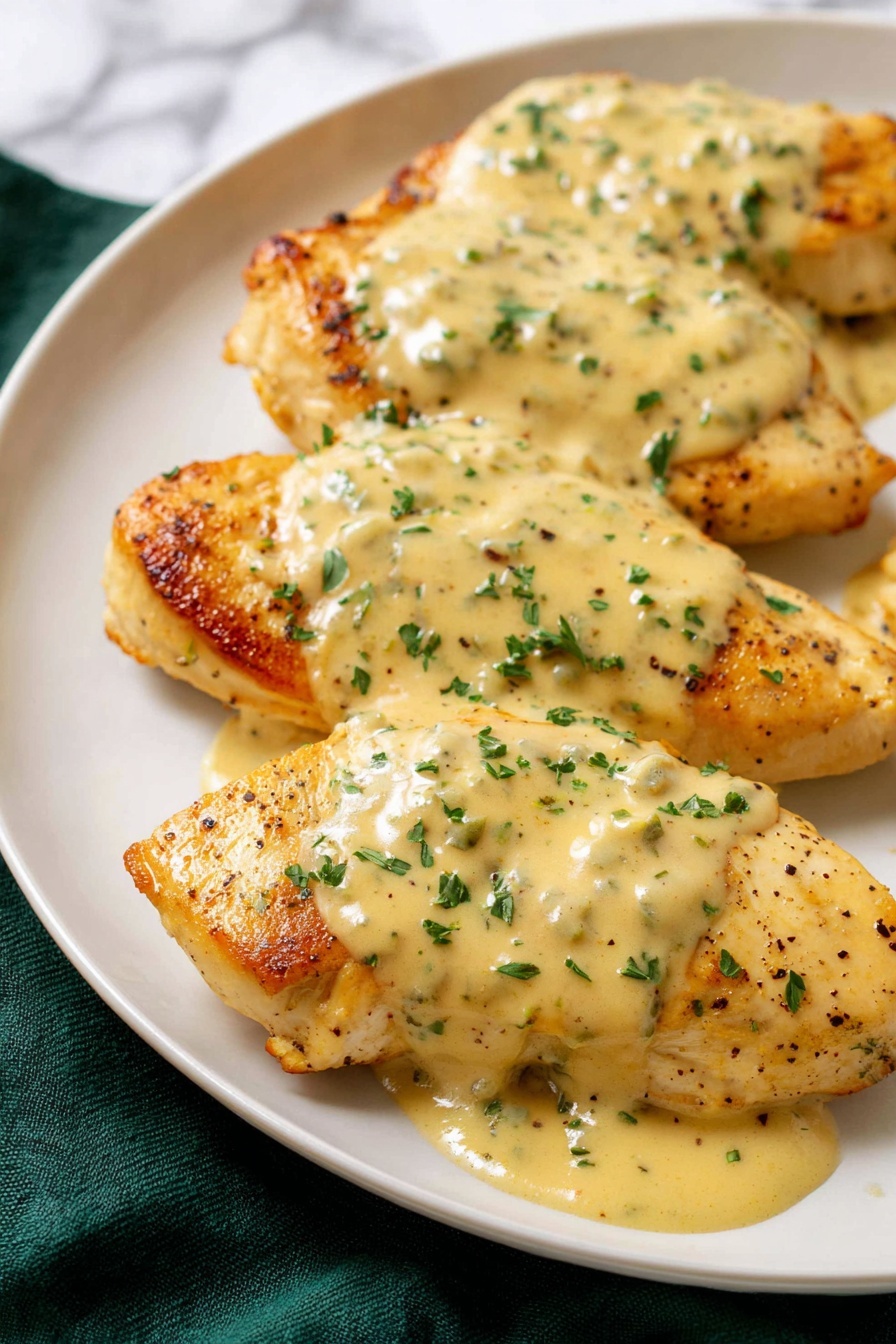

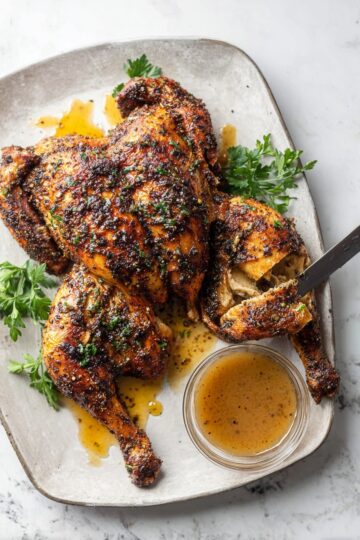

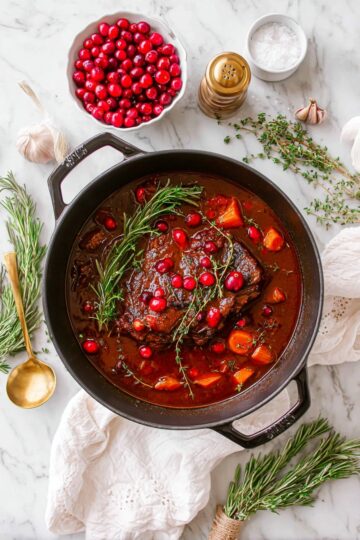

Leave a Reply